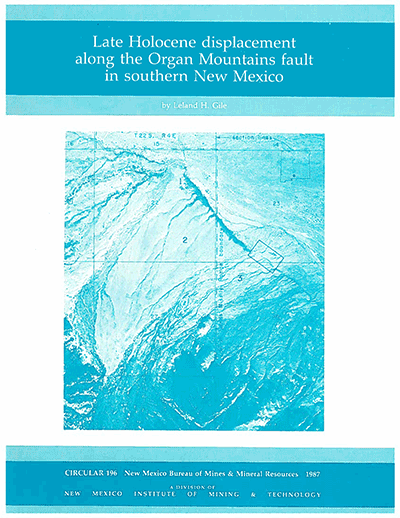
Circular 196—Late Holocene displacement along the Organ Mountains fault in southern New Mexico
By L. H. Gile, 1987, 42 pp., 8 tables, 24 figs., glossary.

A comprehensive study of soils and geomorphology of an extensive fault system in southern New Mexico. Alluvial fans of several ages have been displaced by the fault system, indicating long-term faulting at different times in the same place. These episodes of climatically controlled erosion and deposition provide both discrete deposits and, where the deposits can be dated, a chronology that is independent of faulting and the sedimentation associated with it. The faulting, which was determined to be relatively recent, has particular significance because of potential effects on current urban development and storage of hazardous wastes.
An extensive fault system occurs along the east side of the Organ and San
Andres Mountains in southern New Mexico. Alluvial fans of several ages have
been displaced by the fault, indicating long-term faulting at different
times in the same place. In many arid regions there is widespread evidence
of erosion caused by past changes in climate, particularly by long, severe
droughts after cooler periods with more effective moisture. Thus, episodes
of climatically controlled erosion and deposition provide both discrete
deposits and, where the deposits can be dated, a chronology that is independent
of faulting and the sedimentation associated with it. Charcoal in the lower
parts of such deposits has been dated by 14C methods at the Desert Soil-Geomorphology
Project west and north of the Organ Mountains. These dates give chronological
control on important episodes of sedimentation in the middle and late Holocene
for the area. Soil morphology can be used to distinguish deposits of different
ages if the morphological range has been determined for soils that have
formed deposits. Both the faulting event and the deposits caused by faulting
can then be placed in this chronological framework. Soil features having
chronological significance in the study area are accumulations of organic
carbon, silicate clay, and carbonate, as well as soil color, consistence,
and structure. Soil morphology, coordinated with the geomorphic and stratigraphic
arrangement of the deposits, was used to extrapolate the chronology from
the dated sites to the fault area. The evidence indicates that a major displacement
took place about 1,000 yrs B. P. Maximum displacement is estimated to have
been about 15 ft.
$7.50
Buy
Now
Also available as a free download.
Download
| File Name | Size | Last Modified |
|---|---|---|
| Circular-196.pdf | 2.72 MB | 01/11/2021 03:44:18 PM |



